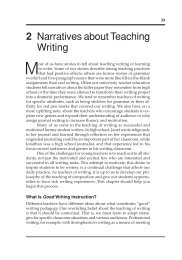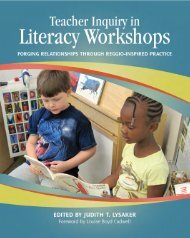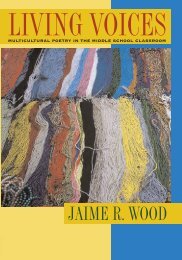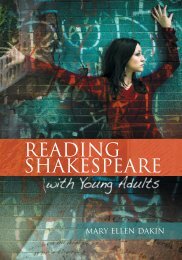Graphic novel Spread - National Council of Teachers of English
Graphic novel Spread - National Council of Teachers of English
Graphic novel Spread - National Council of Teachers of English
- No tags were found...
Create successful ePaper yourself
Turn your PDF publications into a flip-book with our unique Google optimized e-Paper software.
Introduction—Carving a Niche 17<br />
gram. Some <strong>of</strong> the parents remarked that their children had come alive<br />
for the first time doing their homework, which was reminiscent <strong>of</strong> comments<br />
from the Bitz studies (2004). Although some students still<br />
struggled, those who dug into the course did so with real fervor.<br />
Also while I was at UT, I taught in my <strong>English</strong> 102 class Alan<br />
Moore and Dave Gibbons’s graphic <strong>novel</strong> Watchmen (1987) as a text representative<br />
<strong>of</strong> late twentieth-century nuclear hysteria fiction and as a<br />
prophecy text due to its eerie similarities to 9/11 (massive destruction<br />
<strong>of</strong> Manhattan; a villain who was once supported by the United States<br />
and can even be considered a freedom fighter rather than evildoer, depending<br />
on one’s point <strong>of</strong> view; the concept <strong>of</strong> war and horrific events<br />
bringing unity). The discussion yielded much evidence that students<br />
could engage in critical discourse wrapped around a graphic <strong>novel</strong> as<br />
the central text. This augmentative take in conventional curriculum (according<br />
to which the graphic <strong>novel</strong> increases the number <strong>of</strong> primary<br />
texts from which teachers can draw) is one that I hope middle and high<br />
school teachers will eventually use with sequential art narratives, as opposed<br />
to the more common supplemental take (where comics or graphic<br />
<strong>novel</strong>s act as secondary extras to more accepted or canonical texts). But<br />
I understand—we must start somewhere. Most <strong>of</strong> the essays in this collection<br />
feature graphic <strong>novel</strong>s paired with more traditional texts. It is<br />
true that graphic <strong>novel</strong>s can be bridges (Farrell, 1966) to traditional texts.<br />
The opposite is true as well, but <strong>of</strong>ten what surfaces in the essays is the<br />
notion <strong>of</strong> a variety <strong>of</strong> texts working together as equal partners.<br />
After finishing my studies at UT, I returned to teaching, as the<br />
academically and intellectually gifted specialist at a middle school in<br />
rural North Carolina. Once again, I used comics in my curriculum. Just<br />
as research indicates that comics and graphic <strong>novel</strong>s can help ELL and<br />
literacy-challenged populations, it has also suggested that they can have<br />
a positive effect on the lives and learning <strong>of</strong> gifted students. Mitchell<br />
and George (1996), for example, suggest that comics fit well with teaching<br />
gifted children about morals and ethics.<br />
In my grade 6 language arts class, I used comics to help students<br />
explore formats that are typically outside the realm <strong>of</strong> genre studies<br />
taught in regular classrooms. Furthermore, when other teachers approached<br />
me about lack <strong>of</strong> detail in their students’ writing, Spidey and<br />
I again teamed up. I taught a personally crafted lesson entitled “The<br />
Comic Book Show ‘n’ Tell,” an activity described in more detail in Chapter<br />
10.<br />
However, when I decided to take the leap from using simple,<br />
single-issue comics in my lessons to including a complex graphic <strong>novel</strong>,
















